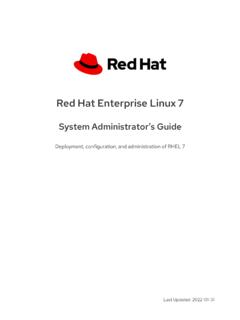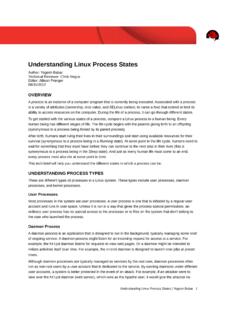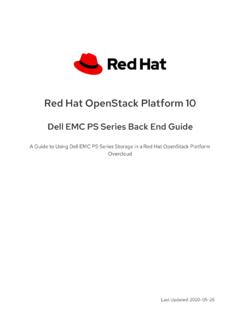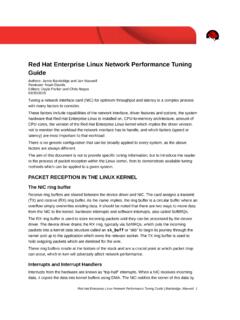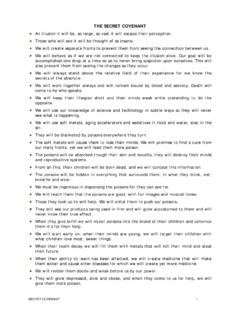Transcription of Red Hat Enterprise Linux 8 System Design Guide
1 Red Hat Enterprise Linux 8 System Design GuideDesigning a RHEL 8 systemLast Updated: 2022-12-12 Red Hat Enterprise Linux 8 System Design GuideDesigning a RHEL 8 systemLegal NoticeCopyright 2022 Red Hat, text of and illustrations in this document are licensed by Red Hat under a Creative CommonsAttribution Share Alike Unported license ("CC-BY-SA"). An explanation of CC-BY-SA isavailable In accordance with CC-BY-SA, if you distribute this document or an adaptation of it, you mustprovide the URL for the original Hat, as the licensor of this document, waives the right to enforce, and agrees not to assert,Section 4d of CC-BY-SA to the fullest extent permitted by applicable Hat, Red Hat Enterprise Linux , the Shadowman logo, the Red Hat logo, JBoss, OpenShift,Fedora, the Infinity logo, and RHCE are trademarks of Red Hat, Inc., registered in the United Statesand other is the registered trademark of Linus Torvalds in the United States and other is a registered trademark of Oracle and/or its is a trademark of Silicon Graphics International Corp.
2 Or its subsidiaries in the United Statesand/or other is a registered trademark of MySQL AB in the United States, the European Union andother is an official trademark of Joyent. Red Hat is not formally related to or endorsed by theofficial Joyent open source or commercial OpenStack Word Mark and OpenStack logo are either registered trademarks/service marksor trademarks/service marks of the OpenStack Foundation, in the United States and othercountries and are used with the OpenStack Foundation's permission. We are not affiliated with,endorsed or sponsored by the OpenStack Foundation, or the OpenStack other trademarks are the property of their respective content covers how to start using Red Hat Enterprise Linux 8. To learn about Red HatEnterprise Linux technology capabilities and limits, see ..Table of ContentsMAKING OPEN SOURCE MORE INCLUSIVEPROVIDING FEEDBACK ON RED HAT DOCUMENTATIONPART I. Design OF INSTALLATIONCHAPTER 1.
3 SUPPORTED RHEL ARCHITECTURES AND System SUPPORTED System REQUIREMENTSCHAPTER 2. PREPARING FOR YOUR RECOMMENDED RHEL INSTALLATION System INSTALLATION BOOT MEDIA TYPES OF INSTALLATION ISO DOWNLOADING A RHEL INSTALLATION ISO Types of installation ISO Downloading an ISO image from the Customer Downloading an ISO image using CREATING A BOOTABLE INSTALLATION MEDIUM FOR Installation boot media Creating a bootable DVD or Creating a bootable USB device on Creating a bootable USB device on Creating a bootable USB device on Mac OS PREPARING AN INSTALLATION Types of installation Specify the installation Ports for network-based Creating an installation source on an NFS Creating an installation source using HTTP or Creating an installation source using Preparing a hard drive as an installation sourceCHAPTER 3. GETTING BOOTING THE Boot Types of boot Editing the boot: prompt in Editing predefined boot options using the > Editing the GRUB2 menu for the UEFI-based Booting the installation from a USB, CD, or Booting the installation from a network using INSTALLING RHEL USING AN ISO IMAGE FROM THE CUSTOMER REGISTERING AND INSTALLING RHEL FROM THE CDN USING THE What is the Content Delivery Registering and installing RHEL from the Installation source repository after System Verifying your System registration from the Unregistering your System from the COMPLETING THE INSTALLATION3031323333333434343536363737 3838404041414243454546464748505254545455 56565757585961616264656667 Table of Contents1.
4 CHAPTER 4. CUSTOMIZING YOUR CONFIGURING LANGUAGE AND LOCATION CONFIGURING LOCALIZATION CONFIGURING System Configuring installation Configuring boot Configuring Configuring network and host name Adding a virtual network Editing network interface Enabling or Disabling the Interface Setting up Static IPv4 or IPv6 Configuring Additional Configuring Connect to Red Introduction to System Configuring Connect to Red Hat Installation source repository after System Verifying your System registration from the Unregistering your System from the Additional Installing System Aligned with a Security About security Configuring a security Additional CONFIGURING SOFTWARE Configuring installation Configuring software CONFIGURING STORAGE Storage device Filtering storage Using advanced storage Discovering and starting an iSCSI Configuring FCoE Configuring DASD storage
5 Configuring FCP Installing to an NVDIMM Criteria for using an NVDIMM device as an installation Configuring an NVDIMM device using the graphical installation CONFIGURING MANUAL Starting manual Adding a mount point file Configuring storage for a mount point file Customizing a mount point file Preserving the /home Creating a software RAID during the Creating an LVM logical Configuring an LVM logical CONFIGURING A ROOT CREATING A USER EDITING ADVANCED USER SETTINGSCHAPTER 5. COMPLETING POST-INSTALLATION TASKS68686971717576767878797980808181828 3848586868686878787909192929393959696979 8989910010110210210510610710810911011111 3 Red Hat Enterprise Linux 8 System Design Guide2.. COMPLETING INITIAL REGISTERING YOUR System USING THE COMMAND REGISTERING YOUR System USING THE SUBSCRIPTION MANAGER USER REGISTERING RHEL 8 USING THE INSTALLER REGISTRATION CONFIGURING System PURPOSE USING THE SUBSCRIPTION-MANAGER COMMAND-LINE SECURING YOUR DEPLOYING SYSTEMS THAT ARE COMPLIANT WITH A SECURITY PROFILE IMMEDIATELY AFTER Profiles not compatible with Server with Deploying baseline-compliant RHEL systems using the graphical Deploying baseline-compliant RHEL systems using NEXT STEPSAPPENDIX A.
6 TROUBLESHOOTINGAPPENDIX B. TOOLS AND TIPS FOR TROUBLESHOOTING AND BUG Using installation log Creating pre-installation log Transferring installation log files to a USB Transferring installation log files over the Detecting memory faults using the Memtest86 Running Verifying boot Consoles and logging during Saving Display settings and device Reporting error messages to Red Hat Customer TROUBLESHOOTING DURING THE Disks are not Reporting error messages to Red Hat Customer Partitioning issues for IBM Power SystemsAPPENDIX C. Resuming an interrupted download Disks are not Cannot boot with a RAID Graphical boot sequence is not X server fails after log RAM is not System is displaying signal 11 Unable to IPL from network storage Using Using rescue Booting into rescue Using an SOS report in rescue Reinstalling the GRUB2 boot Using RPM to add or remove a ip= boot option returns an Cannot boot into the graphical installation on iLO or iDRAC Rootfs image is not initramfsAPPENDIX D.
7 System REQUIREMENTS REFERENCE1131151161171181181211221221231 2412512612712712712712812913013013113113 2132133134134135136137137137138138139139 140141141142143144145146148148149151 Table of Contents3.. HARDWARE SUPPORTED INSTALLATION System DISK AND MEMORY UEFI SECURE BOOT AND BETA RELEASE REQUIREMENTSAPPENDIX E. PARTITIONING SUPPORTED DEVICE SUPPORTED FILE SUPPORTED RAID RECOMMENDED PARTITIONING ADVICE ON SUPPORTED HARDWARE STORAGEAPPENDIX F. BOOT OPTIONS INSTALLATION SOURCE BOOT NETWORK BOOT OPTIONSC onfiguration methods for the automatic CONSOLE BOOT DEBUG BOOT STORAGE BOOT DEPRECATED BOOT REMOVED BOOT OPTIONSAPPENDIX G. CHANGING A SUBSCRIPTION UNREGISTERING FROM SUBSCRIPTION MANAGEMENT Unregistering using command Unregistering using Subscription Manager user UNREGISTERING FROM SATELLITE SERVERAPPENDIX H. ISCSI DISKS IN INSTALLATION PROGRAMCHAPTER 6. BOOTING A BETA System WITH UEFI SECURE UEFI SECURE BOOT AND RHEL BETA ADDING A BETA PUBLIC KEY FOR UEFI SECURE REMOVING A BETA PUBLIC KEYCHAPTER 7.
8 COMPOSING A CUSTOMIZED RHEL System IMAGE BUILDER What is image builder? Image Builder Image builder output Image builder System INSTALLING IMAGE Image builder System Installing image builder in a virtual Reverting to lorax-composer image builder CREATING System IMAGES WITH IMAGE BUILDER COMMAND-LINE Image Builder command-line Creating an Image Builder blueprint with command-line Editing an Image Builder blueprint with command-line Creating a System image with Image Builder in the command-line Basic Image Builder command-line Image Builder blueprint Supported image customizations15115115115215315415415415 5156158160162162166167169171173174175177 1771771781781791801801801811821821821821 8218318418418518618718718718919019119319 4 Red Hat Enterprise Linux 8 System Design Guide4.. Installed Enabled CREATING System IMAGES WITH IMAGE BUILDER WEB CONSOLE Accessing Image Builder GUI in the RHEL web Creating an image builder blueprint in the web console Creating a System image with image builder in the web console PREPARING AND UPLOADING CLOUD IMAGES WITH IMAGE Preparing for uploading AWS AMI Uploading an AMI image to AWS in the Pushing images to AWS Cloud Preparing for uploading Azure VHD Uploading VHD images to Microsoft Azure Uploading VMDK images to Uploading images to GCP with Image Uploading a gce image to GCP using the Authenticating with Specifying credentials with the composer-cli Specifying credentials in the osbuild-composer worker Pushing VMware images to Pushing VHD images to Microsoft Azure Uploading QCOW2 image to Preparing for uploading images to Uploading images to Importing images to Creating an instance of a custom image
9 Using AlibabaCHAPTER 8. PERFORMING AN AUTOMATED INSTALLATION USING KICKSTART INSTALLATION What are Kickstart Automated installation CREATING KICKSTART Creating a Kickstart file with the Kickstart configuration Creating a Kickstart file by performing a manual Converting a Kickstart file from previous RHEL Creating a custom image using Image MAKING KICKSTART FILES AVAILABLE TO THE INSTALLATION Ports for network-based Making a Kickstart file available on an NFS Making a Kickstart file available on an HTTP or HTTPS Making a Kickstart file available on an FTP Making a Kickstart file available on a local Making a Kickstart file available on a local volume for automatic CREATING INSTALLATION SOURCES FOR KICKSTART Types of installation Ports for network-based Creating an installation source on an NFS Creating an installation source using HTTP or Creating an installation source using STARTING
10 KICKSTART Starting a Kickstart installation Starting a Kickstart installation automatically using Starting a Kickstart installation automatically using a local CONSOLES AND LOGGING DURING INSTALLATION1982012022022022032042042052 0720921121121321421521521621621822122322 4225226227227227227228228229229229230230 2302312332342352362362372372382402422432 43244245 Table of Contents5.. MAINTAINING KICKSTART Installing Kickstart maintenance Verifying a Kickstart REGISTERING AND INSTALLING RHEL FROM THE CDN USING Registering and installing RHEL from the Verifying your System registration from the Unregistering your System from the PERFORMING A REMOTE RHEL INSTALLATION USING Performing a remote RHEL installation in VNC Direct Performing a remote RHEL installation in VNC Connect modeCHAPTER 9. ADVANCED CONFIGURATION CONFIGURING System Configuring System Purpose in a Kickstart Additional UPDATING DRIVERS DURING Types of driver Preparing a driver Performing an automatic driver Performing an assisted driver Performing a manual driver Disabling a PREPARING TO INSTALL FROM THE NETWORK USING Network install Configuring a TFTP server for BIOS-based Configuring a TFTP server for UEFI-based Configuring a network server for IBM Power BOOT Types of boot Editing boot Editing the boot: prompt in Editing predefined boot options using the > Editing the GRUB2 menu for the UEFI-based Installation source boot Network boot optionsConfiguration methods for the automatic Console boot Debug boot Storage boot Kickstart boot Advanced installation boot Deprecated boot Removed boot optionsCHAPTER 10.

